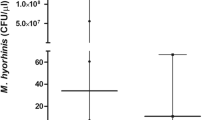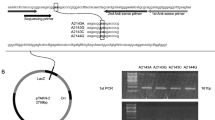Abstract
Molecular detection and analysis of virulence factors of Helicobacter pylori depends on the specificity of cell selection in the gastric biopsies. The laser microdissection (LM) instruments combine microscopy with laser cut sectioning. This combination allows one to choose only the bacteria that are in direct contact with epithelial cells in the gastric biopsy sample, avoiding those microorganisms attached to the mucus layer in the sample. The average concentration of DNA isolated from 25 cuts with selected bacteria is around 1.94 ng/μL, which is enough DNA to perform a qPCR protocol using real-time instruments to amplify 16sDNA or virulence factors like cagA or vacA. Consequently, the application of these technologies in the molecular analysis of Helicobacter pylori directly in contact with the surface of gastric epithelial cells is more precise and could yield better insights about the complex mechanisms of interactions between pathogen and host. Insights derived from research using the techniques described herein may in future facilitate prevention of infection or improved therapeutic options.
Access this chapter
Tax calculation will be finalised at checkout
Purchases are for personal use only
Similar content being viewed by others
References
Versalovic J, Lupski JR (2002) Molecular detection and genotyping of pathogens: more accurate and rapid answers. Trends Microbiol 10:15–21. doi:10.1016/S0966-842X(02)02438-1
Bibby K (2013) Metagenomic identification of viral pathogens. Trends Biotechnol 31:275–279. doi:10.1016/j.tibtech.2013.01.016
Abreu ALP, Souza RP, Gimenes F, Consolaro MEL (2012) A review of methods for detect human Papillomavirus infection. Virol J 9:262. doi:10.1186/1743-422X-9-262
Nahid P, Pai M, Hopewell PC (2006) Advances in the diagnosis and treatment of tuberculosis. Proc Am Thorac Soc 3:103–110. doi:10.1513/pats.200511-119JH
Alzahrani S (2014) Effect of Helicobacter pylori on gastric epithelial cells. World J Gastroenterol 20:12767. doi:10.3748/wjg.v20.i36.12767
Calvet X, Ramírez Lázaro M-J, Lehours P, Mégraud F (2013) Diagnosis and epidemiology of Helicobacter pylori infection. Helicobacter 18:5–11. doi:10.1111/hel.12071
Choi YJ, Kim N, Lim J et al (2012) Accuracy of diagnostic tests for Helicobacter pylori in patients with peptic ulcer bleeding. Helicobacter 17:77–85. doi:10.1111/j.1523-5378.2011.00915.x
de Bernard M, Josenhans C (2014) Pathogenesis of Helicobacter pylori infection. Helicobacter 19:11–18. doi:10.1111/hel.12160
Eusebi LH, Zagari RM, Bazzoli F (2014) Epidemiology of Helicobacter pylori infection. Helicobacter 19:1–5. doi:10.1111/hel.12165
Testerman TL (2014) Beyond the stomach: an updated view of Helicobacter pylori pathogenesis, diagnosis, and treatment. World J Gastroenterol 20:12781. doi:10.3748/wjg.v20.i36.12781
Salama NR, Hartung ML, Müller A (2013) Life in the human stomach : persistence strategies of the bacterial pathogen Helicobacter pylori. Nat Rev Microbiol 11(6):385–399. doi:10.1038/nrmicro3016
Plummer M, Franceschi S, Vignat J et al (2014) Global burden of gastric cancer attributable to H. pylori. Int J Cancer 136:487–490. doi:10.1002/ijc.28999
Abreu MT, Peek RM (2014) Gastrointestinal malignancy and the microbiome. Gastroenterology 146:1534–1546.e3. doi:10.1053/j.gastro.2014.01.001
Micu G, Stăniceanu F, Zurac S et al (2010) Carcinogenesis and infection with Helicobacter pylori. Rom J Intern Med 48:299–306
Backert S, Selbach M (2008) Role of type IV secretion in Helicobacter pylori pathogenesis. Cell Microbiol 10:1573–1581. doi:10.1111/j.1462-5822.2008.01156.x
Saxena A, Shukla S, Prasad KN, Ghoshal UC (2011) Virulence attributes of Helicobacter pylori isolates & their association with gastroduodenal disease. Indian J Med Res 133:514–520
Yamaoka Y (2010) Mechanisms of disease: Helicobacter pylori virulence factors. Nat Rev Gastroenterol Hepatol 7:629–641. doi:10.1038/nrgastro.2010.154
Loh JT, Shaffer CL, Piazuelo MB et al (2011) Analysis of cagA in Helicobacter pylori strains from Colombian populations with contrasting gastric cancer risk reveals a biomarker for disease severity. Cancer Epidemiol Biomark Prev 20:2237–2249. doi:10.1158/1055-9965.EPI-11-0548
Konturek PC, Konturek SJ, Brzozowski T (2009) Helicobacter pylori infection in gastric cancerogenesis. J Physiol Pharmacol 60:3–21
Correa P, Piazuelo MB (2012) Evolutionary history of the Helicobacter pylori genome: implications for gastric carcinogenesis. Gut Liver 6:21–28. doi:10.5009/gnl.2012.6.1.21
Ben Mansour K, Fendri C, Zribi M et al (2010) Prevalence of Helicobacter pylori vacA, cagA, iceA and oipA genotypes in Tunisian patients. Ann Clin Microbiol Antimicrob 9:10. doi:10.1186/1476-0711-9-10
Simone, N. L., Bonner, R. F., Gillespie, J. W., Emmert-Buck, M. R., & Liotta, L. a. (1998). Laser-capture microdissection: Opening the microscopic frontier to molecular analysis. Trends in Genetics, 14(7), 272–276. https://doi.org/10.1016/S0168-9525(98)01489-9
Loayza MF, Villavicencio FX, Santander SC et al (2015) Improved method for extraction and detection of Helicobacter pylori DNA in formalin-fixed paraffin embedded gastric biopsies using laser micro-dissection. MethodsX 2:1–7. doi:10.1016/j.mex.2014.11.003
Vivar N (2010) Manual de procedimientos en anatomía patológica, 1st edn. ROCHE, Quito-Ecuador
Rolls G (2016) Performing a hematoxylin and eosin stain (H&E). Leica Science Lab Tutorial. http://www.leicabiosystems.com/pathologyleaders/performing-a-hematoxylin-and-eosin-stain-a-step-by-step-guide. Accessed 29 Dec 2015
De la Torre Bravo A (2009) Procedimientos endoscópicos en gastroenterología, 2nd edn. Médica Panamericana. Córdova Villalobos, D.T.B.
Lee JY, Kim N (2015) Diagnosis of Helicobacter pylori by invasive test: histology. Ann Transl Med 3:10. doi:10.3978/j.issn.2305-5839.2014.11.03
Churukian C (2009) Microwave modification of the Warthin Starry method for bacteria, 2nd edn. University of Rochester Medical Center. http://www.urmc.rochester.edu/urmc-labs/pathology/stainsmanual/index.html?MICROWAVEMODIFICATIONOFTHEWARTHIN-STARRYMETHODFORBACTERIA. Accessed 20 Dec 2015
Sepúlveda E, Moreno J, Spencer ML, Quilodrán S, Brethauer U, Briceño C, García A (2012) Comparación de Helicobacter pylori en la cavidad oral y mucosa gástrica de acuerdo a genotipo de virulencia (cagA y vacAm1). Rev Chil Infectol 29(3):278–283. doi:10.4067/S0716-10182012000300005
Herrera V (2015) Genotipificación de Helicobacter pylori a traves de PCR en Tiempo real a partir de biopsias gástricas parafinadasde pacientes de Esmeraldas y Quito. Disertation.Universidad de las Fuerzas Armadas ESPE
Author information
Authors and Affiliations
Corresponding author
Editor information
Editors and Affiliations
Rights and permissions
Copyright information
© 2017 Springer Science+Business Media LLC
About this protocol
Cite this protocol
Loayza Villa, M.F., Herrera Sevilla, V.L., Vivar-Diaz, N. (2017). Detection of Helicobacter pylori DNA in Formalin-Fixed Paraffin-Embedded Gastric Biopsies Using Laser Microdissection and qPCR. In: Bishop-Lilly, K. (eds) Diagnostic Bacteriology. Methods in Molecular Biology, vol 1616. Humana Press, New York, NY. https://doi.org/10.1007/978-1-4939-7037-7_4
Download citation
DOI: https://doi.org/10.1007/978-1-4939-7037-7_4
Published:
Publisher Name: Humana Press, New York, NY
Print ISBN: 978-1-4939-7035-3
Online ISBN: 978-1-4939-7037-7
eBook Packages: Springer Protocols




